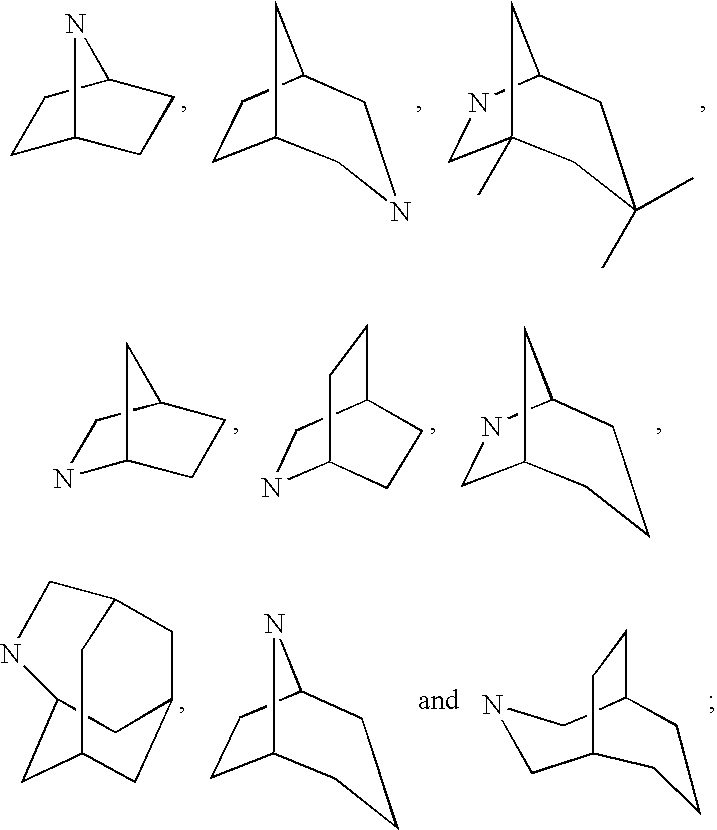Sulfonyl compounds as inhibitors of 11-beta-hydroxysteroid dehydrogenase-1
a technology of sulfonyl compounds and inhibitors, which is applied in the field of sulfonyl derivatives, can solve the problems of reduced glucose and lipid metabolism stimulation effect of insulin in the main insulin-sensitive tissues, namely, muscle, liver and adipose tissues, and insufficient activation of glucose uptake, so as to reduce insulin secretion, improve glucose-stimulated insulin secretion, and reduce intraocular pressure
- Summary
- Abstract
- Description
- Claims
- Application Information
AI Technical Summary
Benefits of technology
Problems solved by technology
Method used
Image
Examples
example 1
[0279]
N-2-adamantyl-4-[2-(ethylsulfonyl)ethyl]bicyclo[2.2.2]octane-1-carboxamide (1-5)
[0280]
Step A:
[0281]Diethyl(ethylsulfonomethane)phosphonate (1.12 g, 4.6 mmol) (Popoff, I. C. et al. J. Org. Chem. 34: 1128-30 (1969)) and 4-carbomethoxybicyclo[2.2.2]octane-1-carboxaldehyde (1-1) (0.82 g, 4.2 mmol) (Adcock, W., Kok, G. B. J. Org. Chem. 50: 1079-1087 (1985)) were dissolved in 8 mL of absolute methanol. The mixture was placed under nitrogen atmosphere, cooled in an ice-bath, and treated with 0.5M solution of sodium methoxide in methanol (8.8 mL, 4.4 mmol). The reaction mixture was kept under reflux for 4 h, then cooled to room temperature, concentrated under diminished pressure, then treated with 2 mL of water and allowed to sit in the refrigerator overnight. The mixture was filtered and the solid washed with a small amount of cold 1:1 MeOH / water. The resulting white solid was collected and dried under vacuum to give the unsaturated sulfone 1-2. MS (ESI+)=287 (M+1).
Step B:
[0282]Sulfo...
example 2
[0288]
N-2-adamantyl-4-[3-(ethylsulfonyl)propyl]bicyclo[2.2.2]octane-1-carboxamide (2-9)
[0289]
Step A:
[0290](Benzyloxycarbonylmethyl)triphenylphosphonium bromide (4.6 g, 9.4 mmol) was azeotroped twice from toluene, and then suspended in 30 mL dry THF. Potassium hexamethyldisilazide (0.5 M in toluene, 16.8 mL, 8.4 mmol) was added dropwise at room temperature and the yellow solution was allowed to stir for 1 h, after which time it became milky white. A solution of 4-carbomethoxybicyclo[2.2.2]octane-1-carboxaldehyde (2-1) (0.50 g, 2.55 mmol) (Adcock, W., Kok, G. B. J. Org. Chem. 50: 1079-1087 (1985)) and benzoic acid (0.015 g, 0.13 mmol) in 2 mL of dry THF was prepared and added dropwise by syringe at room temperature. The mixture was heated to 90° C. and allowed to stir at reflux temperature, after which time the mixture was diluted with 200 mL of ethyl acetate and washed consecutively with 50 mL portions of 1 N HCl (twice), saturated aq. sodium bicarbonate, and brine. The organic layer...
example 3
[0302]
N-2-adamantyl-4-[4-(methylsulfonyl)phenyl]bicyclo[2.2.2]octane-1-carboxamide (3-4)
[0303]
Step A:
[0304]To a stirred solution of methyl 4-phenylbicyclo[2.2.2]octane-1-carboxylate (3-1) (Chapman, N. B. et al. J. Org. Chem., 1970, 35, 917) (4.80 g, 19.6 mmol) in 1,2-dichloroethane (2 ml, 1M) was added methanesulfonyl fluoride (4.05 ml, 58.9 mmol) followed by aluminum trichloride (9.17 g, 68.8 mmol). The reaction mixture was stirred overnight under nitrogen atmosphere at ambient temperature followed by addition of another portion of methanesulfonyl fluoride (4.05 ml, 58.9 mmol) and aluminum trichloride (9.17 g, 68.8 mmol). The resulting mixture was heated at 80° C. for 3 h, then cooled to room temperature and diluted with 300 ml of dichloromethane and 200 ml water. The layers were separated and the aqueous layer was washed with two 100 ml portions of dichloromethane. The organic layers were combined, washed with brine, dried (MgSO4), and concentrated in vacuo. The crude product was ...
PUM
| Property | Measurement | Unit |
|---|---|---|
| waist circumference | aaaaa | aaaaa |
| waist circumference | aaaaa | aaaaa |
| pH | aaaaa | aaaaa |
Abstract
Description
Claims
Application Information
 Login to View More
Login to View More - R&D
- Intellectual Property
- Life Sciences
- Materials
- Tech Scout
- Unparalleled Data Quality
- Higher Quality Content
- 60% Fewer Hallucinations
Browse by: Latest US Patents, China's latest patents, Technical Efficacy Thesaurus, Application Domain, Technology Topic, Popular Technical Reports.
© 2025 PatSnap. All rights reserved.Legal|Privacy policy|Modern Slavery Act Transparency Statement|Sitemap|About US| Contact US: help@patsnap.com



